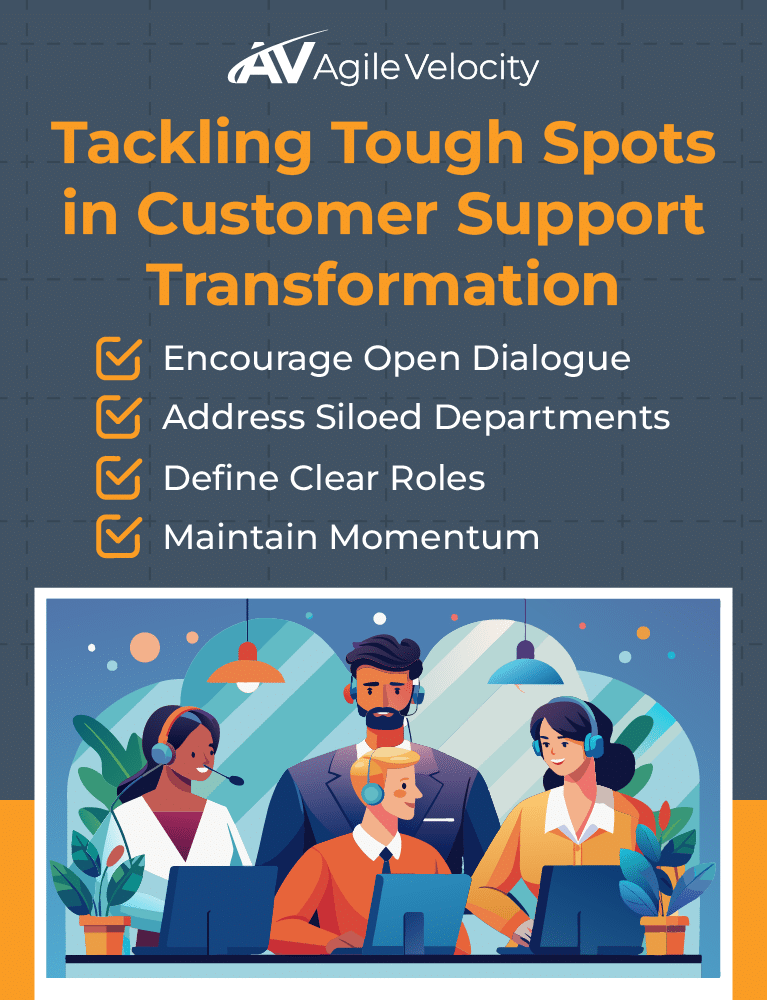Are you ready to transform your customer support function into a proactive, high-performing force? Traditional support methods often rely on reactive approaches, handling each ticket in isolation. This can lead to delays, miscommunication, and a general struggle to keep up with customer expectations. Embracing an approach rooted in a business transformation offers a more effective way to work—one that helps your team respond faster, collaborate more openly, and continuously improve over time.
In this article, you’ll learn how to apply Agile principles to your customer support environment. Whether you’re new to Agile or ready to refine your existing practices, you’ll find practical guidance to shift from a reactive ticketing system to a more proactive, customer-centric team dynamic.
Why Agile Principles Matter for Customer Support Teams
Agile isn’t limited to software development. Its core values—adaptability, transparency, constant feedback, and continuous learning—are equally effective in customer support. Traditional support methods often rely on rigid procedures that result in slow responses; Agile encourages rapid inspection, iterative improvements, and flexible work practices.
When teams regularly review feedback and adapt their work processes, they can detect and address issues early and adjust to customers’ evolving needs more effectively. This customer-centric approach builds stronger customer relationships over time while enhancing overall team performance.
Organizations that adopt Agile strategies often report benefits such as improved communication, better workload management, and a more proactive approach to resolving issues. While the pace and immediacy of these benefits can vary, the overall impact tends to be positive and transformative.
Understanding Agile in Customer Support
Applying Agile to customer support means embedding principles such as transparency, teamwork, and iterative improvement into your daily operations. Several popular frameworks—including Scrum and Kanban—can be adapted to fit support environments, thereby boosting speed and customer satisfaction.
Using Scrum
Scrum organizes work into short cycles known as Sprints. Each Sprint focuses on a set of clearly defined tasks that enable the team to deliver tangible progress quickly.
- Sprints: Time-boxed cycles where the Support Team tackles prioritized tasks in increments.
- Daily Standups: Brief meetings where team members update one another on progress, share immediate challenges, and ensure everyone is aligned.
- Sprint Review and Retrospective: At the end of each Sprint, teams review the work completed, gather customer feedback, and reflect on improvements that can be made in the next cycle.
Leveraging Kanban
Kanban provides a highly visual method for managing work by displaying tasks on a board segmented by stages (e.g., To Do, In Progress, Done). This visual management system allows teams to limit work-in-progress, thereby reducing context switching and fostering quick resolution of customer tickets.
- Kanban Boards: These boards offer a clear, at-a-glance view of ticket status, helping teams to spot bottlenecks and prioritize urgent issues.
- Work in Progress (WIP) Limits: By capping the number of active tasks, teams can maintain focus and work more efficiently.
- Continuous Improvement: Teams using Kanban can rapidly adjust workflows based on tracked metrics, improving both resolution times and overall customer satisfaction.
These iterative approaches allow support teams to address recurring issues more efficiently and to adapt rapidly as customer needs change. By adopting frameworks like Scrum and Kanban, customer support teams can handle complex projects more efficiently, ensuring consistent, high-quality customer experiences across large organizations.
The Benefits of Applying Agile to Customer Support

Applying Agile principles to customer support is a transformative approach that can significantly enhance the function’s effectiveness and efficiency. Agile introduces a culture of adaptability and continuous improvement that empowers support teams to become more responsive and proactive. Traditional customer service models often operate on a reactive basis, dealing with issues as they arise. In contrast, Agile encourages support teams to anticipate customer needs, streamline workflows, and foster a collaborative environment.
By incorporating Agile practices into customer support, organizations can experience:
Enhanced Responsiveness and Problem Resolution
Agile practices such as short Sprints, regular reviews, and iterative retrospectives help teams quickly identify and resolve recurring issues. For example, many consumer electronics companies have adopted such techniques—using short Sprints and frequent reviews—to address customer inquiries tied to feature releases, which contributes to a more satisfying customer experience, even if specific metrics may vary. Regular feedback loops and iterative processes help teams learn from past experiences and refine their strategies, leading to higher service quality and innovation.
Stronger Customer Relationships
Agile methodologies emphasize a customer-centric approach, enabling teams to build better relationships with customers over time by continually adapting to customer feedback. By aligning team goals with customer needs, Agile practices foster significant improvements in customer experience and loyalty. Ultimately Agile helps support teams respond quickly to customer inquiries and issues, improving satisfaction and trust.
Improved Efficiency
Tools like Kanban boards and WIP limits help teams manage increasing ticket volumes by visualizing work, prioritizing high-value tasks, and preventing issues before they escalate. These techniques reduce burnout and stress, helping support teams allocate resources more effectively.
Higher Team Morale and Collaboration
Daily standups, integrated communication, and self-organizing teams empower employees to take ownership of their responsibilities, resulting in a more cohesive work environment. Enhanced team collaboration and transparency lead to better information sharing and a unified approach to problem-solving.
Shifting from Reactive to Proactive Support
Traditional support teams often wait for problems to arise before taking action. An Agile mindset turns this approach on its head, encouraging teams to anticipate issues based on customer feedback and to resolve them before they impact the customer.
Strategies to improve proactive support include:
- Analyzing Customer Data: Regularly review patterns in support tickets and customer feedback to detect trends and recurring issues.
- Iterative Problem-Solving: Divide large challenges into incremental tasks that can be tackled in short iterations, enabling continuous evaluation and refinement of solutions.
- Anticipating Customer Needs: Forecast potential challenges by staying informed about market trends and upcoming changes, and update support documentation proactively.
As Agile becomes more embedded in operational models, forward-thinking organizations will continue to see improvements in both customer satisfaction and operational resilience.
Building Sustainable Success for Customer Support Teams
Creating a long-lasting impact in customer support requires a strategic approach that aligns team practices with Agile principles. Sustainable success is not just about solving today’s problems but ensuring continued high performance and adaptability in a dynamic market. To achieve this, teams must focus on fostering a culture of continuous improvement, maintaining flexibility, and aligning their objectives with the organization’s broader vision. Here’s how these elements contribute to building a successful Agile customer support team:
Utilizing Customer Feedback
- Establish multiple channels for easily gathering customer feedback through surveys, live chats, or post-interaction ratings.
- Regularly review and analyze this feedback, integrating it into your current practices with measurable action items.
Fostering Team Collaboration
- Conduct daily standups and regular Scrum meetings to ensure that everyone is aligned on priorities and emerging roadblocks, regardless of whether teams are on-site or remote.
- Foster a culture of transparency by openly sharing customer insights and issues, encouraging collective ownership of solutions.
Embracing Continuous Improvement
- Hold frequent Sprint Reviews and Retrospectives to assess what worked, what didn’t, and what needs to change, always keeping an eye on both customer and internal performance metrics.
- Use agile coaching and targeted training to refine methods and enhance team performance gradually.
Leveraging Iterative Problem-Solving
- Break down complex issues into smaller, manageable tasks and address them in time-boxed iterations.
- Celebrate small wins, and use each iteration as a learning experience to initiate further improvements.
Incorporating Agile into customer support ultimately reshapes how teams interact with customers, delivering faster, more effective assistance and building enduring relationships.
Overcoming Challenges in Agile Customer Support Implementation
Transitioning to an Agile customer support model can be transformative, yet it often presents challenges that require careful navigation. Resistance to change, entrenched silos, and the need for new roles can pose significant obstacles. However, with the right approach, these challenges can be managed effectively, paving the way for a more dynamic and responsive team. Below is a detailed plan for addressing these potential hurdles in Agile implementation:
- Encourage Open Dialogue:
- Establish frequent feedback sessions to create a culture of openness.
- Ensure every team member feels comfortable sharing ideas and suggesting improvements.
- Address concerns promptly to retain team morale and inclusivity.
- Address Siloed Departments:
- Promote cross-departmental collaboration through joint meetings and integrated workflows.
- Use communication tools that connect all customer-facing teams.
- Foster an organization-wide Agile mindset to dissolve barriers between departments.
- Define Clear Roles:
- Clearly establish and communicate each team member’s role within the Agile framework.
- Designate Agile-specific roles such as Support Scrum Masters and Product Owners to streamline responsibilities.
- Provide role-specific training and support to enhance efficiency and accountability.
- Maintain Momentum:
- Celebrate incremental wins and improvements to keep the team motivated.
- Use visual progress tracking tools to highlight achievements and areas for improvement.
- Conduct regular retrospective meetings to reflect on progress and recalibrate strategies.
Successfully navigating the challenges of Agile implementation in customer support involves fostering a culture of communication, collaboration, and continual learning. By addressing resistance to change, breaking down departmental silos, establishing clear roles, and maintaining momentum, organizations can unlock the full potential of Agile Methodologies to enhance customer satisfaction and team performance.
The Role of Leadership in Agile Customer Support Transformation
Leadership plays a crucial role in successfully implementing Agile within customer support teams. To drive effective transformation, leaders must embody Agile values and actively contribute to creating a culture of continuous improvement, open communication, and accountability. By setting the tone for change and encouraging active participation across all levels of the organization, leadership ensures that Agile practices are consistently applied and that the entire team remains aligned with strategic goals.
Key Leadership Responsibilities:
- Facilitate Team Building:
- Organize regular team-building activities to strengthen collaboration and trust among members.
- Provide opportunities for cross-departmental interactions to encourage a unified approach toward customer support.
- Performance Monitoring:
- Continually review performance metrics, like average response times and customer satisfaction scores, with transparency and open communication.
- Utilize these metrics to identify areas for improvement and recognize achievements.
- Cultivate a Culture of Accountability:
- Encourage a mindset where everyone, from senior executives to frontline support agents, feels accountable for the overall customer experience.
- Promote a shared sense of responsibility towards achieving customer satisfaction and successful outcomes.
- Encourage Continuous Learning:
- Provide ongoing training and development opportunities related to Agile practices, ensuring team members can enhance their skills and apply them in real-world scenarios.
- Foster a learning environment where feedback is leveraged as a tool for growth and innovation.
- Drive Change Management:
- Lead change management efforts by advocating for Agile methodologies and facilitating their integration into daily operations.
- Address resistance by communicating the benefits of Agile practices and illustrating their impact on customer satisfaction and business objectives.
Strong leadership is a catalyst for Agile customer support transformation. By fostering a culture of accountability, transparency, and continuous learning, leaders can guide their teams through the complexities of Agile adoption. This not only enhances customer satisfaction and team performance but also drives sustainable change across the organization, ensuring that customer support services are adaptive and responsive in an ever-changing market landscape.
Measuring and Optimizing Performance in Agile Customer Support
Efficiently measuring and optimizing performance is critical to leveraging Agile methodologies within customer support teams. This process not only helps ensure that support operations meet organizational objectives but also enhances overall customer satisfaction. By understanding and systematically tracking specific metrics, support teams can refine their processes, improve service delivery, and maintain high performance standards. The key is to focus on relevant performance indicators and use insights to inform strategic decisions and ongoing improvements.
Key Performance Metrics:
- Average Response Time:
- Tracks how quickly support teams respond to customer queries.
- Shorter response times typically indicate improved efficiency and customer satisfaction.
- Resolution Rate:
- Measures the percentage of support tickets resolved within predefined ideal time frames.
- A higher resolution rate signifies effective problem-solving and service effectiveness.
- Ticket Volume:
- Refers to the total number of support tickets managed during each Sprint.
- Understanding ticket volume helps in assessing team workload and capacity.
- Customer Satisfaction Scores (CSAT):
- Gathers direct feedback from customers regarding their overall experience and satisfaction with the service.
- High CSAT scores generally reflect a positive customer experience and service quality.
- Net Promoter Score (NPS):
- Determines customer loyalty by assessing the likelihood of recommendations.
- A higher NPS indicates a better customer relationship and potential for increased brand advocacy.
- First Contact Resolution (FCR):
- Evaluates the percentage of issues resolved during the first interaction.
- High FCR rates indicate efficient service and customer-friendly solutions.
- Escalation Rate:
- Measures how often issues need to be escalated to higher-level support.
- Lower escalation rates suggest that initial support is adequate and effective.
- Employee Satisfaction and Engagement:
- Assesses the morale and engagement levels of the support team.
- A motivated team is typically more productive and provides better customer service.
The successful measurement and optimization of performance in Agile customer support hinges on consistently tracking and evaluating these key metrics. By doing so, organizations can take informed actions to streamline operations, enhance team efficiency, and ultimately provide a superior customer experience. Regular reviews of performance indicators during Sprint Retrospectives not only refine existing processes but also identify new opportunities for improvement, ensuring that the support team remains agile, proactive, and aligned with customer expectations. This continuous cycle of evaluation and enhancement fulfills the integral role Agile plays in sustaining top-tier customer support services.
Future-Proof Your Customer Support with Agile

Embedding Agile practices within customer support workflows—whether by increasing visual workflow transparency or expediting rapid problem resolution—can enhance a team’s capacity to adapt, innovate, and deliver an improved overall customer experience.
Building an Agile customer support team is not just about speeding up ticket resolution. It’s about creating a dynamic, customer-centric environment that continuously learns and adapts. By focusing on collaboration, iterative review cycles, and clear performance metrics, Agile methods can elevate the quality of customer support, build stronger customer relationships, and foster operational excellence.
Ready to innovate and transform your customer support? Contact Agile Velocity today to start implementing Agile methodologies today and turn challenges into opportunities for continuous improvement.





